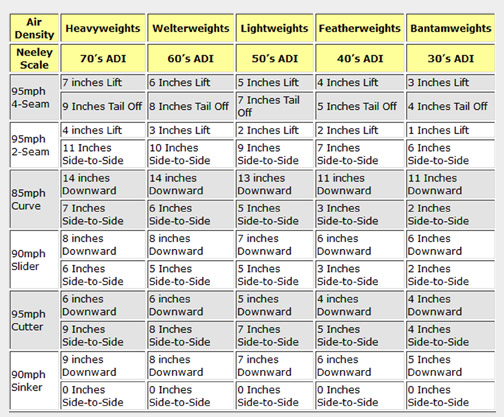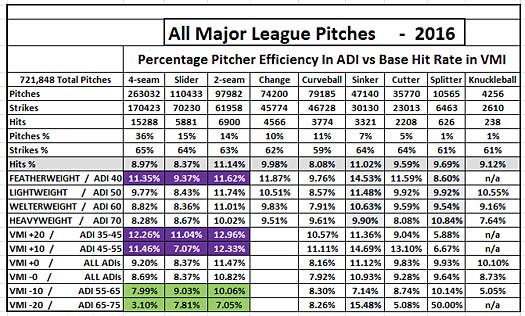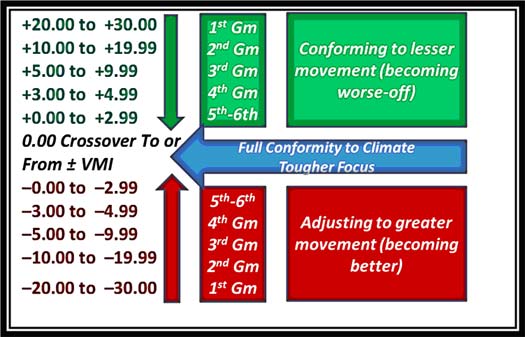

The objective of this section is to help you gain insight into "when" teams and individual players will be more effective. If you know the VMI, then you know the hitter's set-up tendency for today, and you will have a clearer picture of the hitter's capability to adjust to a particular pitch. For example; if the "tail-off" on the Four-Seamer is lifting 6 inches today at a 65 ADI as shown below, but the hitter is used to that amount of movement and sports a +4.00 VMI today, then the following should be a tip for you, or the pitcher, or catcher:
This hitter may be more susceptible to being induced into a groundball with the two-seamer. This is because his set-up (that is; his swing vs. what he sees) will be above the four-seamer's tail-off and fully prepared to meet that lifting pitch upon its arrival at the zone. The two-seamer however, lifts less than the hitter is expecting from the four-seamer for which he is most often prepared, so he will need to bring the bat further downward to hit it and most likely will result in a groundball.
Everyone in baseball knows why and how to use the two-seamer, they just don't always know "when," as there has never been an analysis of the physical properties of the air causing late movement allowing an analysis of the hitter's preparation.
Now, imagine the opposite scenario, whereby the hitter is not used to that amount of movement, but has been playing in about 59 ADI. His VMI will be as great as -4.00 or greater negative, therefore his setup to swing will naturally be below the center of the four-seamer until he adjusts.
This team's hitters would tend to be more dangerous against the two-seamer, because the set-up is closer to where the hand-eye coordination needs to be to hit the two-seamer on a line.

The ADI provides a microscope on the pitcher. The VMI provides a microscope on the hitter. MLB generates approximately 750,000 pitches per year, and new pitches are very rare, therefore the information below will remain consistent year in and year out, thus the effectiveness of the Las Vegas lines, etc.
Bottom Line: Pitchers will be more successful against a team with a high minus VMI (greater than -5.00 Reverse to the hitters' normal home environment) than when the team sports a "Plus VMI of 5.00 or greater - Tight or easier to hit the four-seamer than normal"

The two-seamer is simply a pitch thrown with the ball rotated 90 degrees from the 4-seam grip position. Since there are only two short seams spinning backward, the lift is less than when four seams are whipping the air. Also, due to the typical 75o to 80o arm angle of the pitcher, the circular seams acting against the air cause a Frisbee© effect, sliding the ball in the direction of the slant.
If you note that the pitcher your hitting team or player is matched up against in today's or tomorrow,s game is prone to throwing a high number of two-seamers, then he will be more successful against a High Plus VMI team than a High Minus VMI team with that pitch.
The change-up is obviously an off-speed pitch which is a timing nightmare for the hitter. It is generally more effective when the high velocity pitches are being hit hardest. However, the air resistance on such a slow pitch does not appear to be a factor in its effectiveness.
Above, I have referred to four different types of pitchers that we can compare effectiveness rates against the ADI and the VMI:
Overall, focus on the data vs the VMI reveals the following tendencies for an entire team and for the individual hitters alike: When a team enters a new series with a high plus VMI they will begin to conform from the first game throughout the two, three, or four game series. If they continue in a similar environment for an additional series, they will eventually become fully conformed to the environment. Remember, they would not be identified as a high plus team if they had not arrived in this environment from a locale which produced greater ball movement. When the team becomes fully conformed to this new, lesser movement environment, it has become a team that will be disadvantaged when they leave for a greater movement venue or weather condition.

...reveals the following tendencies for an entire team and for the individual hitters alike: When a team enters a new series with a high minus VMI it will begin to adjust from the first game throughout the two, three, or four game series. If it continues in a similar environment for an additional series, it will eventually become fully adjusted to the environment. Remember, they would not be identified as a high minus team if they had not arrived in this environment from a locale which produced lesser ball movement. When the team becomes fully adjusted to this new, greater movement environment, it has become a team that is advantaged if they leave the first series and second series for a venue of lesser movement and again become a higher plus VMI team.

© 2020 Air Resistance Technologies, Inc., All Rights Reserved.
BaseballVMI.com, 1326 51st Avenue, Greeley, CO. 80634